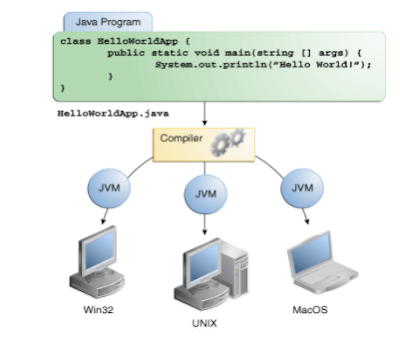Talk about Java technology seems to be everywhere, but what exactly is it? The following sections explain how Java technology is both a programming language and a platform, and provide an overview of what this technology can do for you.
n the Java programming language, all source code is first written in plain text files ending with the .java extension. Those source files are then compiled into .class files by the javac compiler. A .class file does not contain code that is native to your processor; it instead contains bytecodes — the machine language of the Java Virtual Machine1 (Java VM). The java launcher tool then runs your application with an instance of the Java Virtual Machine.
Because the Java VM is available on many different operating systems, the same .class files are capable of running on Microsoft Windows, the Solaris™ Operating System (Solaris OS), Linux, or Mac OS. Some virtual machines, such as the Java SE HotSpot at a Glance, perform additional steps at runtime to give your application a performance boost. This includes various tasks such as finding performance bottlenecks and recompiling (to native code) frequently used sections of code.
The Java platform has two components:
You've already been introduced to the Java Virtual Machine; it's the base for the Java platform and is ported onto various hardware-based platforms.
The API is a large collection of ready-made software components that provide many useful capabilities. It is grouped into libraries of related classes and interfaces; these libraries are known as packages.
Reference : Oracle Docs
The Java Programming Language
The Java programming language is a high-level language that can be characterized by all of the following buzzwords:- Simple
- Object oriented
- Distributed
- Multithreaded
- Dynamic
- Architecture neutral
- Portable
- High performance
- Robust
- Secure
n the Java programming language, all source code is first written in plain text files ending with the .java extension. Those source files are then compiled into .class files by the javac compiler. A .class file does not contain code that is native to your processor; it instead contains bytecodes — the machine language of the Java Virtual Machine1 (Java VM). The java launcher tool then runs your application with an instance of the Java Virtual Machine.
Because the Java VM is available on many different operating systems, the same .class files are capable of running on Microsoft Windows, the Solaris™ Operating System (Solaris OS), Linux, or Mac OS. Some virtual machines, such as the Java SE HotSpot at a Glance, perform additional steps at runtime to give your application a performance boost. This includes various tasks such as finding performance bottlenecks and recompiling (to native code) frequently used sections of code.
The Java Platform
A platform is the hardware or software environment in which a program runs. We've already mentioned some of the most popular platforms like Microsoft Windows, Linux, Solaris OS, and Mac OS. Most platforms can be described as a combination of the operating system and underlying hardware. The Java platform differs from most other platforms in that it's a software-only platform that runs on top of other hardware-based platforms.The Java platform has two components:
- The Java Virtual Machine
- The Java Application Programming Interface (API)
You've already been introduced to the Java Virtual Machine; it's the base for the Java platform and is ported onto various hardware-based platforms.
The API is a large collection of ready-made software components that provide many useful capabilities. It is grouped into libraries of related classes and interfaces; these libraries are known as packages.








0 comments:
Post a Comment